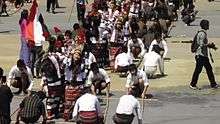Chapchar Kut Festival

The Chapchar Kut Festival is a festival of Mizoram, India.[1] It is celebrated during March after completion of their most arduous task of Jhum operation i.e., jungle-clearing (clearing of the remnants of burning). It is a spring festival celebrated with great fervour and gaiety. Chapchar Kut is estimated to have started in 1450-1700 A.D. in a village called Suaipui. Chapchar Kut was discouraged when the Missionaries came to Mizoram as it was felt that it did not adhere to Christian values, however it was revived in 1973 on a mass scale sans animistic practice and Alcohol.[2] Chapchar Kut is now held annually in the Month of March. Chapchar Kut is one of three annual festivals of the Mizos celebrated to mark three different stages of the agricultural cycle. The other two are Mim Kut and Pawl Kut, also revived in the last century.
Oral traditions say Chapchar Kut was first celebrated in Seipui village in adjoining Myanmar that has a sizeable population of Mizos and their ethnic cousins. Chapchar Kut used to be celebrated to thank the gods for saving the people from harm during the clearing of forest on hill slopes for jhum cultivation at the beginning of a year.
Today, the festival is observed in the last part of February or the early part of March when the trees and bamboos felled for jhum are left to dry and the shifting cultivators have time to relax and enjoy.[3]
References
- ↑ Barthakur, Dilip Ranjan (2003). The Music And Musical Instruments Of North Eastern India. Mittal Publications. p. 55. ISBN 978-81-7099-881-5. Retrieved 8 August 2012.
- ↑ Thanzawna. "Origin of Chapchar Kut". Mizoram.nic.in. Retrieved 9 August 2012.
- ↑ Hindustan Times. "Egged on: Mizoram festival revives pre-Christian custom". hindustantimes.com. Retrieved 8 March 2016.